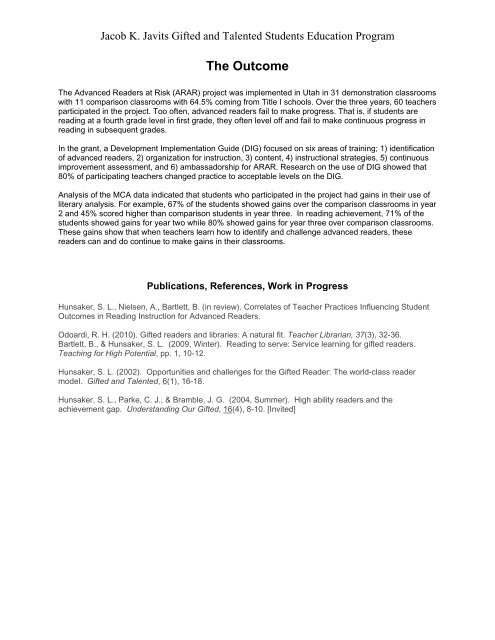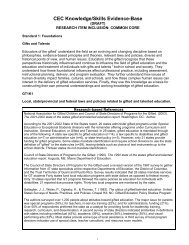Advanced Readers At Risk: Rescuing an Underserved ... - NAGC
Advanced Readers At Risk: Rescuing an Underserved ... - NAGC
Advanced Readers At Risk: Rescuing an Underserved ... - NAGC
Create successful ePaper yourself
Turn your PDF publications into a flip-book with our unique Google optimized e-Paper software.
Jacob K. Javits Gifted <strong>an</strong>d Talented Students Education Program<br />
The Outcome<br />
The <strong>Adv<strong>an</strong>ced</strong> <strong>Readers</strong> at <strong>Risk</strong> (ARAR) project was implemented in Utah in 31 demonstration classrooms<br />
with 11 comparison classrooms with 64.5% coming from Title I schools. Over the three years, 60 teachers<br />
participated in the project. Too often, adv<strong>an</strong>ced readers fail to make progress. That is, if students are<br />
reading at a fourth grade level in first grade, they often level off <strong>an</strong>d fail to make continuous progress in<br />
reading in subsequent grades.<br />
In the gr<strong>an</strong>t, a Development Implementation Guide (DIG) focused on six areas of training; 1) identification<br />
of adv<strong>an</strong>ced readers, 2) org<strong>an</strong>ization for instruction, 3) content, 4) instructional strategies, 5) continuous<br />
improvement assessment, <strong>an</strong>d 6) ambassadorship for ARAR. Research on the use of DIG showed that<br />
80% of participating teachers ch<strong>an</strong>ged practice to acceptable levels on the DIG.<br />
Analysis of the MCA data indicated that students who participated in the project had gains in their use of<br />
literary <strong>an</strong>alysis. For example, 67% of the students showed gains over the comparison classrooms in year<br />
2 <strong>an</strong>d 45% scored higher th<strong>an</strong> comparison students in year three. In reading achievement, 71% of the<br />
students showed gains for year two while 80% showed gains for year three over comparison classrooms.<br />
These gains show that when teachers learn how to identify <strong>an</strong>d challenge adv<strong>an</strong>ced readers, these<br />
readers c<strong>an</strong> <strong>an</strong>d do continue to make gains in their classrooms.<br />
Publications, References, Work in Progress<br />
Hunsaker, S. L., Nielsen, A., Bartlett, B. (in review). Correlates of Teacher Practices Influencing Student<br />
Outcomes in Reading Instruction for <strong>Adv<strong>an</strong>ced</strong> <strong>Readers</strong>.<br />
Odoardi, R. H. (2010). Gifted readers <strong>an</strong>d libraries: A natural fit. Teacher Librari<strong>an</strong>, 37(3), 32-36.<br />
Bartlett, B., & Hunsaker, S. L. (2009, Winter). Reading to serve: Service learning for gifted readers.<br />
Teaching for High Potential, pp. 1, 10-12.<br />
Hunsaker, S. L. (2002). Opportunities <strong>an</strong>d challenges for the Gifted Reader: The world-class reader<br />
model. Gifted <strong>an</strong>d Talented, 6(1), 16-18.<br />
Hunsaker, S. L., Parke, C. J., & Bramble, J. G. (2004, Summer). High ability readers <strong>an</strong>d the<br />
achievement gap. Underst<strong>an</strong>ding Our Gifted, 16(4), 8-10. [Invited]

















